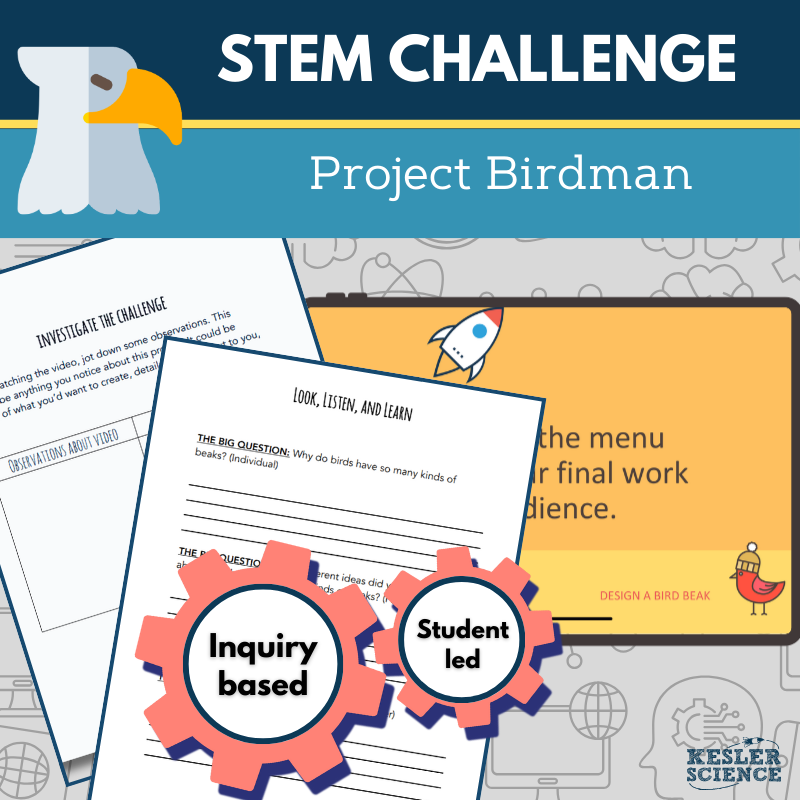
STEM Challenge - Project: Birdman - Design a Bird Beak for a Feeding Frenzy
Looking for a flexible, multi-day activity that gets your students “doing science?” Every STEM Challenge offers a hands-on, inquiry-based, student-led project designed to allow them to step into the roles of researchers and engineers.
STEM Challenge projects are ideal for use at any time throughout the school year, between units, before breaks, or during afternoons when testing weeks occur.
For teachers, there are presentations and step-by-step guides to facilitate pacing and lesson plans that align with standards. Students utilize the included notebooks to guide them through activities (both individually and in small groups), challenge them to learn new information, and reflect on and apply the information they have learned.
The Challenge:
Have you ever noticed that different species of birds have different shaped beaks? You would expect birds that live in the same habitat to eat the same food sources. However, to avoid competition with each other, birds have had to adapt over time to fill different niches within the habitat. One of those adaptations is the shape of the birds beak, which is used to gather and eat food. You will be given a limited amount of supplies to construct bird beaks which are best suited to gather and capture food within the niche. The problem is that you don't know what the niches or food will look like. Each of your beaks will be highly specialized to gather the most food possible in a given timeframe. Your beaks will need to overcome the following feeding behaviors: tearing, cracking, sipping, drilling, picking, probing, striking, straining, and scooping. Do your research about the feeding behaviors to have the best chance of success during the challenge. Along the way you will also uncover how Charles Darwin's theory of evolution by natural selection is related to bird beaks. Get to work. The survival of your species depends on it!
What’s in a STEM Challenge?
- a video explaining the engineering challenge and setting the context for the project
- a BIG Question to guide the inquiry
- teacher presentation in PPT (Google-compatible) and Keynote
- a teacher's guide on what the teacher and students should be doing along the way
- student notebook offers
- questions to provide the students with a framework for their inquiry throughout the entire project
- opportunities to absorb new information and reflect on ways to use it to complete the challenge
- Using the LAUNCH process, students brainstorm with their peers and reflect on failures and opportunities, with the prospect of sharing their ideas with the world. This holds students accountable, and they will put forth the best effort, knowing that other students could critique the project.
- Each STEM Challenge contains a list of suggested supplies for its project. We were very cautious about choosing inexpensive items, and the supply list is dynamic, allowing for adjustments to individual situations. Suggested supplies include:
- plastic silverware
- toothpicks
- rubber bands
- cardboard
- chopsticks
- straws
- pencils
- scissors
- pipe cleaners
- plastic bottle tops
- paper
- beans
- rice
- marbles
- sponge
- Nerds (candy)
- pistachios with shells
NGSS Standards
Aside from the engineering components of this project, students will be learning about Charles Darwin and his theory of evolution through natural selection.
NGSS: MS-ETS1-1, MS-ETS1-2, MS-ETS1-3, MS-ETS1-4, MS-LS4-4, MS-LS4-6
Pickup currently not available
Terms of Use
Copyright © Kesler Science, LLC. All rights reserved by the author. This product is to be used by the original downloader only. Copying for more than one teacher, classroom, department, school, or school system is prohibited. Permission is never granted to enter Kesler Science materials into any form of AI for any purpose. This product may not be distributed or displayed digitally for public view. Failure to comply is
copyright infringement and a violation of the Digital Millennium Copyright Act (DMCA). Clipart and elements found in this PDF are
copyrighted and cannot be extracted and used outside of this file without permission or license. Intended for classroom and personal use ONLY. Multiple licenses are available for purchase by departments,
schools, or school districts. Contact support@keslerscience.com for more information.









